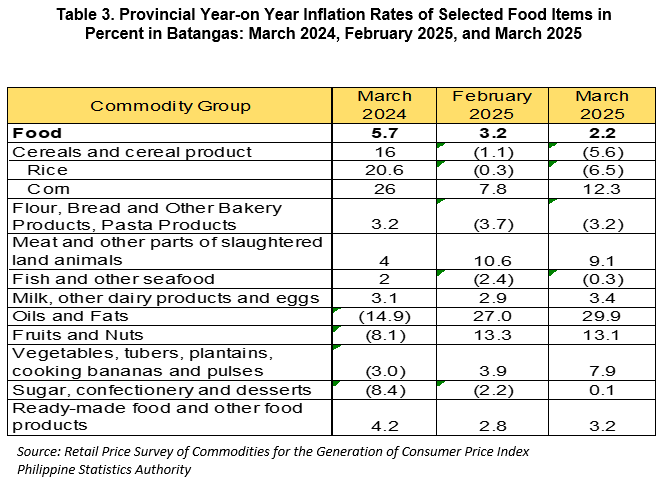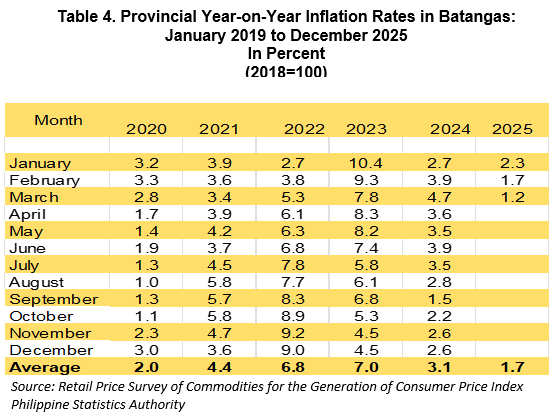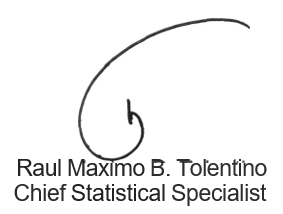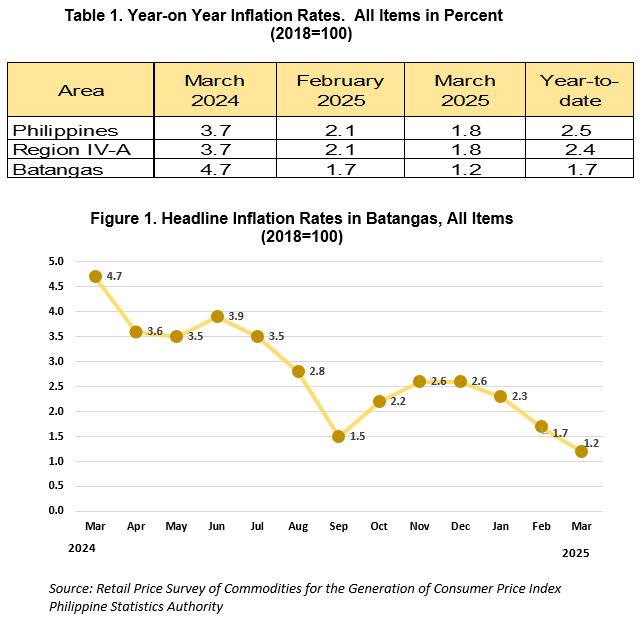
Headline Inflation
The Batangas Province headline or overall inflation slowed down further to 1.2 percent in March 2025 from 1.7 in February 2025. This brings the provincial average inflation from January to March 2025 to 1.7 percent. In March 2024, the inflation rate was higher at 4.7percent. (Table 1 and Figure 1)
On the other hand, Region IV-A CALABARZON decreased to 1.8 percent in March 2025 from 2.1 in February 2025. In CALABARZON, the Province of Quezon has the highest inflation rate at 3.4 percent in March 2025. It was followed by the provinces of Laguna at 2.2 percent, Rizal at 2.1 percent and Batangas at 1.2 percent in second, third and fourth, respectively. The Province of Cavite remained the lowest inflation rate at 1.1 percent in March 2025.
Moreover, the Philippines’ overall inflation continues to slow down at 1.8 percent in March 2025 from 2.1 percent in February 2025. In March 2024, the inflation rate was higher at 3.7 percent (Table 1).
Main Drivers to the Downward Trend of the Headline Inflation
The downtrend in the overall inflation in March 2025 was primarily brought about by the slower annual decrement of food and non-alcoholic beverages at 2.3 percent in March 2025 from 3.2 percent in the previous month. Also contributed to the downtrend was the faster year-on-year decrease in the housing, water, electricity, gas and other fuels index at (0.2) percent during the month from a 0.5 percent annual drop in February 2025. In addition, a slower inflation rate was for the transport index at (2.1) percent in March 2025 from (1.5) percent in the previous month.
Moreover, slower annual increases were noted in the indices of the following commodity groups in March 2025.
a. Furnishings, household equipment and routine household maintenance, (0.2) percent from 0.0 percent
b. Clothing and Footwear, 0.1 percent from 0.2 percent
c. Recreation, Sport and Culture, 2.1 percent from 2.2 percent
a. Alcoholic Beverages and Tobacco, 6.0 percent from 5.0 percent
b. Health, 2.9 percent from 2.5 percent
c.Information and Communication, 0.2 percent from 0.0 percent
d. Personal care and miscellaneous goods and services, 2.4 percent from 2.0 percent
The indices of the rest of the commodity groups retained their respective previous month’s annual rates. (Table 2)
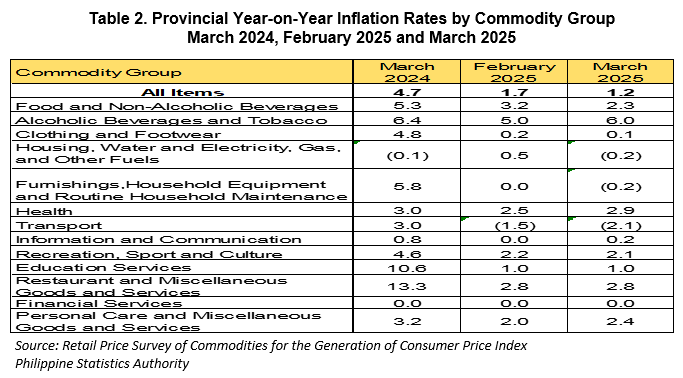
Main Contributors to the Headline Inflation
The top three commodity groups contributing to the March 2025 overall inflation were the following:
a. Food and non-alcoholic beverages with 56.4 percent share or 0.68 percentage point
b. Restaurants and accommodation services with 29.2 percent share or 0.35 percentage point
c. Alcoholic Beverages and Tobacco with 12.4 percent share or 0.15 percentage point
Food Inflation
Food inflation in Batangas further eased to 2.2 percent in March 2025 from 3.2 percent in the previous month. In February 2024, food inflation was higher at 5.7 percent. (Table 3)
The deceleration of food inflation in March 2025 was primarily brought about by the faster year-on-year decline of rice at (6.5) percent in March 2025 from (0.3) percent in the previous month. This was followed by the slower inflation rate of meat and other parts of slaughtered land animals at 9.1 percent in March 2025 from 10.6 percent in February 2025, and fruits and nuts at 13.1 percent during the month from 13.3 percent in the previous month.
Moreover, slower year-on-year increases were observed in the indices of corn at 12.3 percent in March 2025 from 7.8 percent in the previous month, vegetables, tubers, plantains, cooking bananas and pulses at 7.9 percent from 3.9 percent in February 2025 and sugar, confectionery and desserts at 0.1 percent during the month from (2.2) percent in the previous month.
On the other hand, higher annual growth rates during the month were observed in the indices of the following food groups:
a. Corn, 12.3 percent from 7.8 percent
b. Flour, bread and other bakery products, pasta products and other
cereals, (3.2) percent from (3.7) percent
c. Fish and other seafood, (0.3) percent from (2.4) percent
d. Milk, other dairy products and eggs, 3.4 percent from 2.9 percent
e. Oils and fats, 29.9 percent from 27.0 percent
f. Ready-made food and other food products, 3.2 percent from 2.8 percent
Food inflation shared 50.5 percent or 0.61 percentage points to the overall inflation in March 2025. The top three food groups in terms of contribution to the food inflation during the month were the following:
a. Meat and other parts of slaughtered land animals with a share of 94.3 percent or 2.07 percentage point
b. Vegetables, tubers, plantains, cooking bananas and pulses with a share of 27.3 percent or 0.60 percentage point
c. Fruits and nuts with a share of 22.8 percent or 0.50 percentage point
